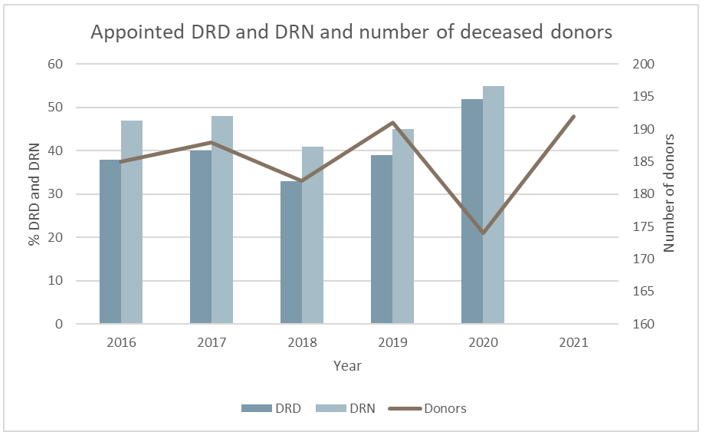Appointed donor responsible doctor and donor responsible nurse increase organ transplantation in Sweden
Wenche Stribolt1, Camilla Olofsson1, Helena Almen1.
1National Center for Donation, National Board of Health and Welfare, Stockholm, Sweden
Introduction: To follow up the quality and efficacy of the organ donation process, and subsequently to increase organ transplantation in Sweden, the National board of Health and Welfare uses five quality indicators. Donor Responsible Doctor (DRD) and Donor Responsible Nurse (DRN) have a key role in promoting donation and supporting the quality assurance of the donation process in the ICU. The appointment of DRD and DRN is one of the indicators. This abstract focuses on the development of appointed DRD and DRN between the years 2016-2021, thus including the unprecedented covid-19 year of 2020. Donors in numbers are also presented.
Method: According to the national target value, 100 % of the intensive care units (ICUs) should have appointed DRD and DRN with written assignment description and the recommended time for the assignment (2-8 hours/week depending on the type of ICU). Appointed DRD and DRN is reported by the health care professionals into the Swedish Intensive Care Registry (SIR) since 2016. Data for 2021 is not available at the time of submission, but will be available at the conference. The number of utilized donors for the years 2016-2021 is retrieved from Scandiatransplant. Descriptive statistics, proportion of appointed DRD and DRN and number of utilized donors, are presented.
Results: The appointed DRD and DRN were as followed in 2016; 38% and 47%, 2017; 40% and 48%, 2018; 33% and 41%, 2019; 39% and 45%, 2020, 52 % and 55 % (those ICUs not reporting are not included in the calculations). Although the proportion of DRD and DRN has increased from 2016 to 2020 it is far from the set goal of 100%. Those ICUs not reporting DRD and DRN were in 2016; 28%, 2017; 14%, 2018; 14%, 2019; 9%, 2020; 25% (combined for DRD and DRN). The results for 2021 will be presented at the conference. The numbers of utilized donors were in 2016; 185, 2017; 188, 2018; 182, 2019; 191, 2020; 174, 2021; 192.
Discussion: DRD and DRN have a key role in promoting organ donation. The reasons for the high number of ICU’s not reporting appointed DRD and DRN (25%) during the covid-19 pandemic year 2020 compared to previous years is not known. It could be explained by a displacement effect due to the pandemic. Either were the DRD and DRN not appointed, or there was simply a lack of time to report to SIR. Although the number of donors dropped from 191 in 2019 to 174 in 2020, one could have expected a greater decrease due to the pandemic. Also, in 2021 the number of utilized donors reached 192. These results indicate that, despite the strain caused by the pandemic, the ICUs managed to identify donors. The indicators DRD and DRN has to be reviewed in depth, and be correlated to the numbers of donors within each region of Sweden.
Conclusion: The main findings show that DRD and DRN are not being appointed as required by the Swedish regulations, or not being reported to SIR as should. As the number of utilized donors increased in 2021, the negative effects of the pandemic were limited.

right-click to download
